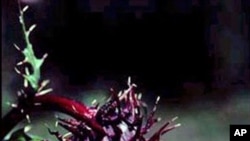A new global analysis of the world's known plant species concludes that one-fifth of them are at risk of extinction due to human activities.
Scientists from Britain's Royal Botanic Gardens, the Natural History Museum London, and the International Union for the Conservation of Nature jointly investigated the status of 7,000 species from the five major groups of plants, a representative sampling from the approximately 400,000 known plants around the world.
The scientists poured over the vast plant collections at the Museum and Botanic Gardens, and surveyed digital data and field observations from cooperating investigators around the world, including the Missouri Botanical Garden in the United States.
The group did not have enough data on 3,000 of the plant species to make an assessment of their extinction risks. But among the remaining 4,000 species, the investigators listed 22 percent of the plants as being anywhere from near-threatened and vulnerable to critically endangered.
Nearly two-thirds of the endangered plants are found in tropical rainforests, habitats which are themselves at risk, according to the International Union for the Conservation of Nature's Craig Hilton-Taylor. He says the number of at-risk plant species could well be higher because scientists continue to discover new ones every year.
Hilton-Taylor, who manages the organization's so-called "Red List" of endangered species, says the message from the new analysis is clear.
"It is not just the cute and furry animals that are under threat. But it is really the basic fabric of the planet. The plants we are completely dependent on for many of our food resources, for sources of medicine, large parts of the world are so dependent on wild plants for primary health care," said Hilton-Taylor. "And we cannot afford to lose that diversity of plants because it would have a massive impact on people around the world and their livelihoods."
The percentage of plants species determined to be at risk is similar to the number of endangered animals on the International Union for the Conservation of Nature Red List for mammals.
Hilton-Taylor says the organization determines whether a plant species is endangered by measuring the extensiveness of its range and whether the known population of that plant appears to be increasing or decreasing.
Hilton-Taylor says his organization also factors in evidence of human activities that threaten the viability of plant species
"Are they being overused by people, are they being exploited for medicinal purposes, are they traded commercially because they are beautiful ornamental plants," he said.
Hilton-Taylor notes that a plant that makes it onto the International Union for the Conservation of Nature endangered list is not necessarily doomed to extinction.
"Conservation interventions may come into force. People save these plants from becoming extinct, which would be really great news. Other cases, some of these species are very long lived and can persist in very low numbers before they fall off the edge and go extinct," he said.
The new Red List plant assessment is part of an international effort to monitor at regular intervals the changing status of the world's plants, fungi, and animals, as they face continued challenges from human population growth and climate change. The results of the latest assessment will be presented later this month to world leaders at a U.N.-sponsored global biodiversity conference in Nagoya, Japan.
News
Twenty Percent of World's Plants at Risk




